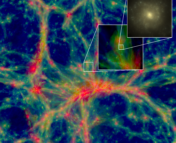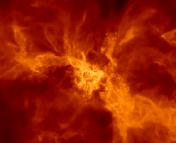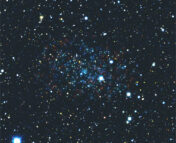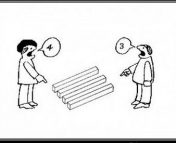
This guest post was written by Alex Gurvich, a 5th year Ph.D. student at Northwestern University. Alex studies galaxy formation using supercomputer simulations as a member of the FIRE collaboration. When not doing research, he organizes his department’s public outreach efforts. His terminal font is comic sans, and that should tell you all you need to know about him.
Title: Genetically modified halos: towards controlled experiments in ΛCDM galaxy formation
Authors: Nina Roth, Andrew Pontzen, Hiranya V. Peiris
First Author’s Institution: Department of Physics and Astronomy, University College London, Gower Street, London, WC1E 6BT, UK
Status: Published in MNRAS
Today’s paper features a mashup of words that might take you by surprise, as we’ll be talking about genetically modified halos in cosmological simulations. Let’s break that down piece-by-piece (leaving genetic for last). A (dark matter) halo is a fundamental building block of the universe, forming the backbone scaffolding on which galaxies form. A cosmological simulation is a computer simulation of a modest chunk of the universe (typically cubes with ≳ 100 Mpc to a side) that is evolved over time. In these simulations, initial conditions (ICs) are generated with statistics taken from observations of the cosmic microwave background (CMB) at redshift z=99 and then evolved forward in time. Depending on the size of the simulation, hundreds to thousands of halos can form in the simulation volume.
Calculating the forces on all the particles in these simulations can be very computationally expensive and so they are often run at a relatively low resolution. However, this can interfere with science goals that rely on accuracy below the resolution limit. To answer those questions that require high resolution, sub regions of the simulation can be re-simulated at substantially higher resolution in what are called “cosmological-zooms.” This has the dual advantage of producing halos with very high resolution while still including consistent cosmological surroundings. One drawback to this approach is that the (by design) low number statistics of simulating a single halo, vs. simulating many halos, make it difficult to evaluate the extent to which the stochastic properties of the halo’s evolution (such as the merger and/or mass accretion history) can affect the end scientific results.
To quantify the importance of these stochastic properties, one would typically compare zooms of different halos (with different merger and mass accretion histories). However, this comparison is a bit apples-to-oranges since even basic properties, like the final halo mass, can be very different between the two different halos. Instead, one would like to tweak some properties of the evolution but keep most the same in order to, in a controlled way, quantify the effect the individual properties have on the scientific question of interest. Enter genetic modification.
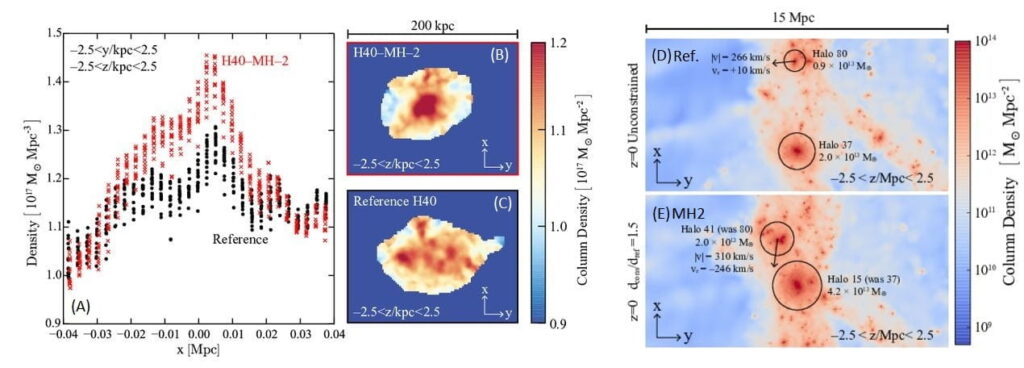
Halos made to order
As mentioned above, the initial conditions of a cosmological simulation are taken from the CMB. Specifically, they are modeled as a gaussian random field with the same variance as observed in the CMB. The secret sauce in today’s paper is that, reminiscent of the classic example of the Datasaurus dozen, they enforce specific constraints on the ICs without changing the overall statistics. In this case, the specific constraints they make on the ICs allow them to increase/decrease the density around the particles at redshift z=99 that will eventually form the halo of interest at redshift z=0 while still matching the overall statistics of the CMB. It’s in this sense that the modifications are “genetic,” since they are made when the halo is still an “embryo” and come to fruition much later in the halo’s life. Figure 1 demonstrates the effect of this procedure, comparing the ICs at redshift z=99 (left, panels B and C) vs. the ensuing halos at redshift z=0 (right, panels E and D). Comparing panels (E) and (D) by eye we see that the genetically modified simulation, MH2, is noticeably denser (and the halo masses are larger, indicated by the annotation on the figure) while preserving many of the identifying features of the original (like the orientation of the cosmic filaments feeding into the halo, e.g. bottom right of panels E and D).
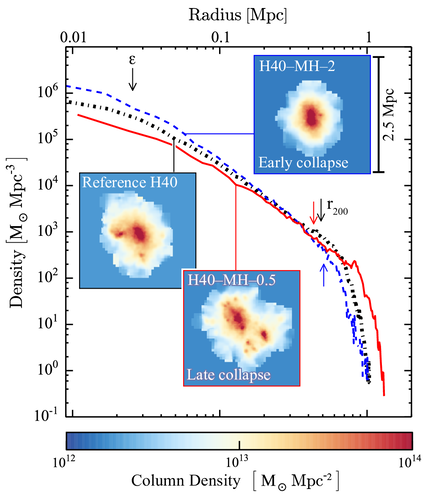
Figure 2 shows this more quantitatively by comparing the densities of the ensuing halos as a function of radius between the reference simulation and two modified simulations: one with lower density (MH0.5, identified as “late collapse”) and one with higher density (MH2, as above, identified here as “early collapse”). Here we can clearly see that the mass in MH2 is more centrally concentrated (blue dashed curve) than the reference simulation (black dotted curve) and both are more centrally concentrated than MH0.5 (red curve). Likewise, at large radii, MH0.5 has a higher density than the reference simulation and both have higher densities than MH2.
That is to say, the authors are successful in showing that their procedure for nudging the ICs at redshift z=99 indeed produces halos that are slightly different but share many of the same properties by redshift z=0, allowing them to make true apples-to-apples comparisons between the different halos. In addition to providing a proof of concept for a remarkably useful new method for modifying simulation ICs, the authors also apply their new method to quantify how much the merger and accretion history contribute to the scatter in the observed relationship between initial density and collapse time. Spoiler alert: contrary to what is often argued, it’s not much– really driving home the importance of genetic modification. To learn more, you’ll have to check out the paper yourself!
Astrobite edited by Ellis Avallone
Featured image credit: Figure 3 in the paper.

